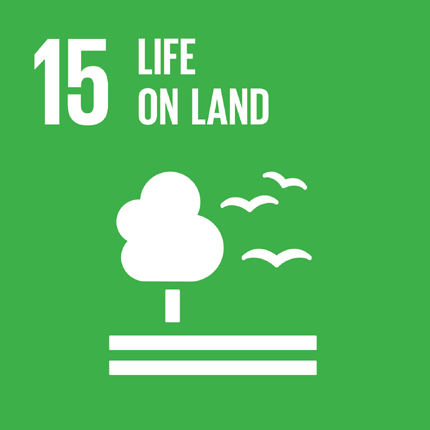sdg15
SUSTAINABLE DEVELOPMENT GOAL 15
Protect, restore and promote sustainable use of terrestrial ecosystems, sustainably manage forests, combat desertification, and halt and reverse land degradation and halt biodiversity loss
Progress of goal 15
- Preserving diverse forms of life on land requires targeted efforts to protect, restore and promote the conservation and sustainable use of terrestrial and other ecosystems. Goal 15 focuses specifically on managing forests sustainably, restoring degraded lands and successfully combating desertification, reducing degraded natural habitats and ending biodiversity loss.
- Between 1990 and 2015, the world’s forest area diminished from 31.7 per cent of the world’s total land mass to 30.7 per cent. The loss was mainly attributable to the conversion of forest to other land uses, such as agriculture and infrastructure development. Meanwhile, other areas were transformed into forests through planting, landscape restoration or the natural expansion of forest. Owing to the balance of the two processes and efforts to slow deforestation, the global net loss of forest area declined from 7.3 million hectares per year in the 1990s to 3.3 million hectares per year during the period from 2010 to 2015.
- To safeguard places that contribute significantly to global biodiversity, protected areas have been established and identified as key biodiversity areas. In 2014, 15.2 per cent of the world’s terrestrial and freshwater environments were covered by protected areas. The percentage of terrestrial key biodiversity areas covered by protected areas has increased, from 16.5 per cent in 2000 to 19.3 per cent in 2016. Over the same period, the share of freshwater key biodiversity areas that are protected has increased from 13.8 per cent to 16.6 per cent, and the share of mountain key biodiversity areas under protection has grown from 18.1 per cent to 20.1 per cent.
- The focus in Goal 15 on halting biodiversity loss comes at a critical time, since many species of amphibians, birds and mammals are sliding towards extinction. According to the International Union for Conservation of Nature’s Red List Index, amphibians are declining most rapidly in Latin America and the Caribbean, primarily as a result of the chytrid fungal disease, one of numerous wildlife diseases on the rise worldwide. The greatest extinction risks for birds and mammals are found in South-Eastern Asia, mainly owing to the conversion of lowland forests. However, their decline is not inevitable, with extinction risks for vertebrate species having been reversed in five small island developing States (the Cook Islands, Fiji, Mauritius, Seychelles and Tonga) as a result of conservation actions over the past several decades.
- Conservation efforts can also be thwarted by poaching and the trafficking of wildlife. Since 1999, at least 7,000 species of animals and plants have been detected in illegal trade, and the list of species under international protection continues to grow. Comparing the size of legal trade in wildlife products (about 900,000 transactions per year) to the quantity of wildlife seized (about 16,000 seizures per year) provides an indication of the scope of illicit wildlife trafficking. The value of legal and illicit wildlife products can also be compared. For example, the value of recorded seizures of Crocodylus genus represents between 0.4 per cent and 0.6 per cent of the value of legal protected exports of this species between 2009 and 2013, with no clear trend discernible.
- In 2014, bilateral ODA to support biodiversity amounted to $7 billion, an increase of 16 per cent in real terms over 2013. The two largest recipients of biodiversity assistance were the Philippines and India, which together received about $1 billion of the total aid.
Source: United Nations, Department of Economic and Social Affairs, SUSTAINABLE DEVELOPMENT KNOWLEDGE PLATFORM
The National Indicators for Sustainable Development Goal 15 are:
- Share of forest areas (%)
All available data in .xls file:
Last Updated: 28/4/2025
EU SDG indicator set
To measure SDG achievement in an EU context, an EU SDG indicator set was developed under the leadership of Eurostat. The purpose of this set, which is structured along the 17 global Sustainable Development Goals, is to monitor progress towards the SDGs at the European level.
- For the complete set of indicators available in the Eurostat database, click here.
- To compare Greece’s progress on specific indicators for each Sustainable Development Goal, click here [data visualisation].

